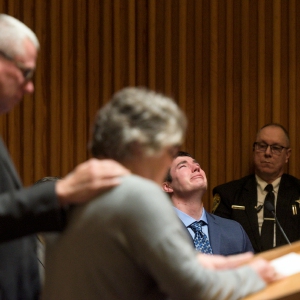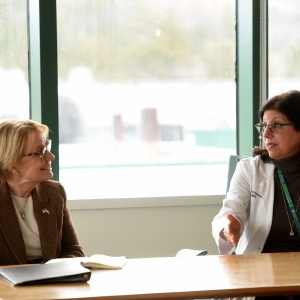Column: Making the case for urine-diverting toilets
| Published: 12-24-2024 10:37 AM |
Phosphorus conservation probably isn’t something you think about often. But alongside helium, lithium and other elements of increasing scarcity, our phosphorus supply is rapidly depleting. You may know phosphorus as an important mineral for your bones and teeth. It can be found in many foods, such as beans and nuts. but it is also a key component of what we use to produce crops: fertilizer.
The way things are going, too much phosphorus is ending up in New Hampshire’s lakes. This is bad for two reasons. First, phosphorus is really good at making things grow. For farming, that’s wonderful, but too often, phosphorus ends up where it isn’t needed. In recent years, many of New Hampshire’s lakes have experienced a surge in surface blooms of blue-green algae largely because of phosphorus abundance. Blue-green algae is an eye-catching but toxic growth that inhibits the use of lakes for recreation, has lowered property values by up to 3.8% in some areas and wreaks havoc on lake ecology. Research suggests it can also cause of variety of health effects.
Second, as phosphorus continues to collect in lakes and other bodies of water, it is not being recycled back through the human ecosystem. No efficient filtration system for reclaiming phosphorus from water exists, so this vital mineral will eventually run out. Phosphorus ends up in bodies of water when high concentration sources of the mineral leach into them. This occurs when an outdated septic system contaminates groundwater, when erosion causes fertilizer runoff and every day when we flush toilets. According to MIT, we have around 80 years until all known phosphorus reserves will be exhausted. Phosphorus is as essential for our bodies to function as it is for crop production; there is no way around it.
To mitigate phosphorus loss, farms can plant trees on banks to minimize erosion and phosphorus-based fertilizer can be replaced with manure. But these are not the only measures that can be taken to save phosphorus. We need to begin implementing urine-diverting toilets (UDTs) in our waste-disposal systems. This would entail installing the toilets when plumbing renovations are needed and connecting with farmers who could take advantage of this resource in a way similar to how manure is used. While the use of treated urine as a source of phosphorus in farming is a safe practice that exists in many cultures, it is worth noting that the process has not yet been accepted for use in organic farming practices.
UDTs are a system that can be integrated into plumbing systems to divert human urine. This is possible because UDTs are built in a way that allows pee to divert to a different pipe than other human waste. Urinals can also be connected to this system. The pee is temporarily stored on site and can either be pasteurized there or at a receiving facility. The urine would be collected every 2-4 weeks and transported by an organization like the Rich Earth Institute to conventional farms for use as a fertilizer on fields to reintroduce elements like phosphorus, nitrogen and potassium into the soil. Several countries have implemented UDTs, and just this year a small community on Cape Cod adopted them.
While these systems can be installed anywhere, they may be most effective in public buildings, and particularly in public schools. Kids are adaptable to change and by taking this measure, we would expose new generations to a system that will inevitably be used in the future. Installing UDTs in public schools also would mean that lots of people would use them, and the system could be incorporated into the science curriculum. For these reasons, there has been a push in recent years to adopt this system in the Climate Action Plans in the SAU 70 school district, which comprises Hanover and Norwich.
A major barrier to the implementation of these toilets has been the understandable stigma around human waste. This project is the opposite of flashy, but just like mainstream sustainability initiatives, it is of vital importance. While the costs of implementing this system vary, UDTs save money on the water bill. They can save around 1.6 gallons of water per flush according to research by Hanover High School students as part of a proposal to the Dresden School Board when I was enrolled there. Some also worry about safety due to pharmaceuticals that are present in human urine, but because of pasteurization and further degradation by soil microbes, this does not pose a health risk. This system is not only necessary for conservation’s sake, it’s worth it.
Overall, the benefits of UDTs far outweigh the inconveniences. However much it might gross people out, it is a safe practice and an effective one. Install a UDT and save phosphorus, summer fun, future generations and local housing markets all at the same time.
Article continues after...
Yesterday's Most Read Articles
 Citing insufficient evidence, county attorney declines to prosecute former Lebanon Public Works employees who were accused of theft
Citing insufficient evidence, county attorney declines to prosecute former Lebanon Public Works employees who were accused of theft
 Dartmouth alumnus gets 20-to-40-year sentence in rape case
Dartmouth alumnus gets 20-to-40-year sentence in rape case
 President of Vermont Law and Graduate School to step down this summer
President of Vermont Law and Graduate School to step down this summer
 Walkout at Dartmouth calls attention to Trump’s attacks on universities, conditions in Gaza
Walkout at Dartmouth calls attention to Trump’s attacks on universities, conditions in Gaza
Anna Aaron is majoring in Economics and Environmental Studies at Dickinson College in Pennsylvania and is a graduate of Hanover High School.






 Editorial: New Hampshire budget shortfall is a crisis of Republican design
Editorial: New Hampshire budget shortfall is a crisis of Republican design Editorial: Time is running out for American democracy
Editorial: Time is running out for American democracy Editorial: Jeanne Shaheen blazed a trail in politics
Editorial: Jeanne Shaheen blazed a trail in politics Column: Federal funding for medical research puts America first
Column: Federal funding for medical research puts America first
